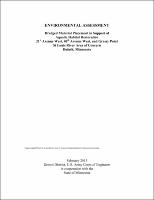Please use this identifier to cite or link to this item:
https://hdl.handle.net/11681/38137| Title: | Environmental Assessment : Dredged Material Placement in Support of Aquatic Habitat Restoration, 21st Avenue West, 40th Avenue West, and Grassy Point, St. Louis River Area of Concern, Duluth, Minnesota |
| Authors: | United States. Army. Corps of Engineers. Detroit District |
| Keywords: | Duluth (Minn.) Saint Louis River (Minn. and Wis.) Dredging Dredging spoil Stream restoration Environmental management Environmental protection |
| Publisher: | United States. Army. Corps of Engineers. Detroit District. |
| Abstract: | The Detroit District, U.S. Army Corps of Engineers (USACE), proposes to place suitable shoal material dredged from the Federal navigation project into State-specified target areas to reduce water depths and allow for natural colonization of aquatic vegetation. Habitat islands may also be included for added diversity. The State of Minnesota, in concert with the approved St. Louis River Area of Concern Remedial Action Plan (RAP) for the St. Louis River Area of Concern (SLRAOC), proposes to use dredged material that will be placed in-water as fill in support of aquatic habitat restoration efforts to remove beneficial use impairments in the SLRAOC. Consistent with achieving the restoration goals set forth in the RAP, suitable dredged material would be provided from the Federal navigation channel, Erie Pier, and/or other sources in accordance with United States Army Corps of Engineers (USACE) and State of Minnesota standards. Placement of the dredged material will provide for improvement of benthic substrate and development of aquatic habitat features towards the goal of delisting beneficial use impairments (BUIs) from the AOC—specifically UI #4, “Degradation of Benthos,” and BUI #9, “Loss of Fish and Wildlife Habitat.” The proposed restoration sites include the 21st Avenue West, 40th Avenue West, and Grassy Point which encompass approximately 890 acres in a near-continuous length of shoreline of approximately 3.5 miles. The dredged material will provide a base of shallower areas of varying depths (and possibly habitat islands) for State-proposed habitat features such as softened shorelines and aquatic habitats interspersed with open water areas to support a diverse assemblage of vegetation, fish and wildlife. Areas of contaminated sediment would be buried to isolate it from exposure to benthic organisms (bottom dwelling organisms). The State of Minnesota intends to provide growth medium at each restoration site using organic sediment excavated from the Kingsbury Bay and/or Perch Lake RAP restoration sites to promote growth of submergent and emergent aquatic vegetation. |
| Description: | Environmental Assessment |
| Rights: | Approved for Public Release; Distribution is Unlimited |
| URI: | https://hdl.handle.net/11681/38137 |
| Appears in Collections: | Environmental Documents |
Files in This Item:
| File | Description | Size | Format | |
|---|---|---|---|---|
| Duluth Dredged Material Placement EA_2015.pdf | 3.62 MB | Adobe PDF |  View/Open |